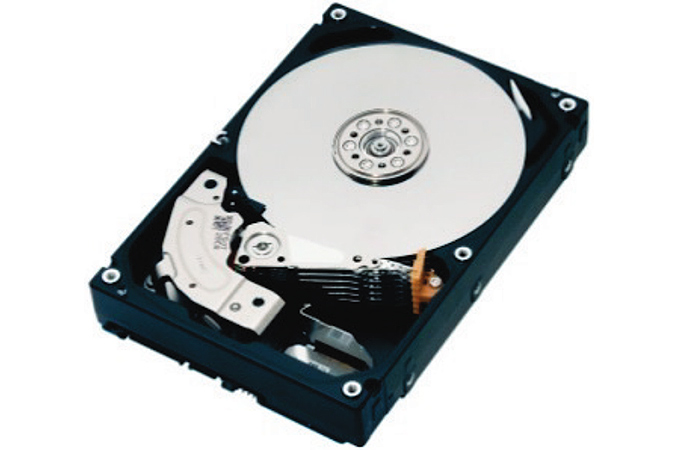Toshiba Announces MN05ACA-Series HDDs: Up to 8 TB
by Anton Shilov on February 15, 2017 9:15 AM EST
Toshiba has announced a new family of 3.5" hard drives for home and SOHO NAS devices. The new MN-series HDDs have up to 8 TB of capacity and support some of the features found in Toshiba’s enterprise-class hard drives. The performance of the new HDDs is similar to the performance of high-end hard drives from other makers, all due to increased areal density.
The Toshiba MN-series family includes 4 TB, 6 TB and 8 TB models with a SATA 6 Gb/s interface (note that the higher-end model supports the SATA 3.3, whereas the others are compliant with the SATA 3.1). The HDDs feature 7200 RPM spindle speed, are equipped with 128 MB buffers, and use rotational vibration (RV) sensors that detect and compensate for transient vibrations in multi-bay NAS and server environments - this aims to ensure that the drives deliver consistent performance. Speaking of performance, Toshiba declares up to 230 MB/s sustained data transfer rate as well as 4.17 ms average latency time for the top-of-the-line 8 TB model.
The new drives are based on several PMR platters (perpendicular magnetic recording) but are not filled with helium. (Helium can be used to increase the number of disks per drive beyond six). The Toshiba MN05ACA800 therefore uses six 1.33 TB platters, and the other drives use either fewer platters or ones with a lower capacity (as well as lower areal density).
| Toshiba MN-Series HDDs | ||||||
| MN05ACA800 | MN05ACA600 | MN04ACA400 | ||||
| Capacity | 8 TB | 6 TB | 4 TB | |||
| RPM | 7200 RPM | |||||
| Interface | SATA 3.3 6 Gbps | SATA 3.1 6 Gbps | ||||
| DRAM Cache | 128 MB | |||||
| Data Transfer Speed (Sustained) |
230 MB/s | 205 to 230 MB/s | 195 to 205 MB/s | |||
| MTBF | 1 million hours | |||||
| Rated Annual Workload (read and write) | 180 TB/year | |||||
| Acoustics (Seek) | 33 dB | 30 dB | ||||
| Power | Operating | 9.2 W | 10.1 W | 9.6 W | ||
| Active Idle | 6.2 W | 6.7 W | 5.2 W | |||
| Warranty | unknown | |||||
The MN-series HDDs from Toshiba are rated for 24/7 availability, with 1 million hours MTBF as well as a 180 TB/year workload rating. While the MTBF and the annual workload ratings are considerably lower when compared to enterprise-class hard drives, the MN-series still offer higher endurance compared to regular desktop HDDs.
The Toshiba MN-series HDDs will be available in the coming weeks and months, but the manufacturer has not published its recommended prices just yet.
Related Reading:
Source: Toshiba











23 Comments
View All Comments
SharpEars - Wednesday, February 15, 2017 - link
Why does the 6 TB unit draw more power than the 8 TB unit - very weird.RaichuPls - Wednesday, February 15, 2017 - link
Same amount of platters, lower density means your spindle has to spin faster.ddriver - Wednesday, February 15, 2017 - link
That doesn't make any sense. The effect of lower density is lower sequential speed, which is reflected in the chart. Same goes for the drives identical RPM.BrokenCrayons - Wednesday, February 15, 2017 - link
They're using highly precise stepper motors to maintain 7200 RPM across all models of drives. I don't think variance in rotation speed would account for the difference in power consumption.It might be the case that the 6TB model is using lower density platters and thus has the highest number of them among the series. That _could_ account for the power differences and it'd make a lot more sense than different rotational speeds.
cygnus1 - Thursday, February 16, 2017 - link
Yeah, the drives are all spinning the same RPM. Perhaps the lower density platters are actually heavier or maybe require more head movement which both would equate to more power usage.Samus - Saturday, February 18, 2017 - link
The 4TB and 6TB drives seem to be built on previous generation components, having SATA 3.1 controllers. These could draw slightly more power.The power numbers are also likely peak numbers, and since only the 8TB model has a consistent BOM, I'd guess they are compensating for different platter configurations. The models with fewer 1.33TB/platter configuration will inevitably draw less power than the models with lower density 6x1TB\5x800GB platters built on previous manufacturing technology (heavier)
My takeaway from this chart is, as usual, get the highest end model if you can afford it, or stick with a known-reliable previous gen model.
extide - Friday, February 24, 2017 - link
No, dude, they are all 7200 RPM (its right in the specs) -- so obviously more platters = more rotating mass, more heads, etclosergamer04 - Wednesday, February 15, 2017 - link
I'd guess it's a different SATA chip that accounts for the change in power.Penti - Wednesday, February 15, 2017 - link
Different HDD-controller obviously, even the 4TB-model uses more peak power.Ginner.N - Wednesday, February 15, 2017 - link
Why HDD now a days have Endurance rating ? Also will the warranty be void if i somehow managed to write more data than the specified rating ?